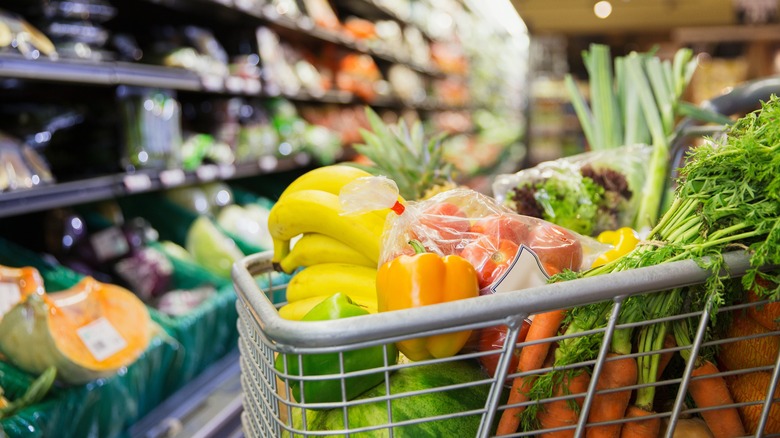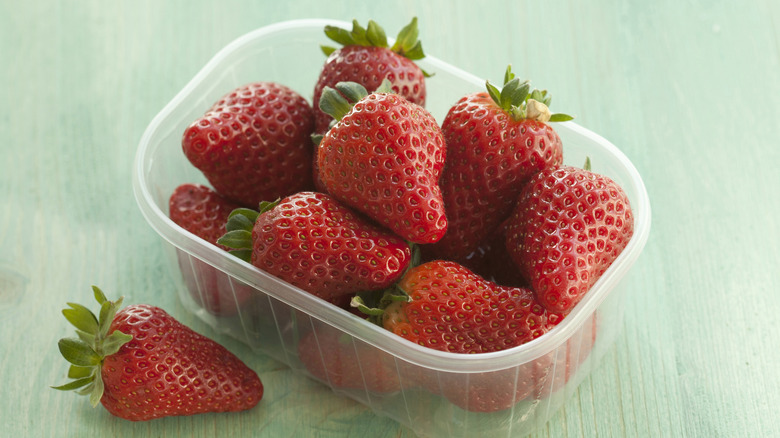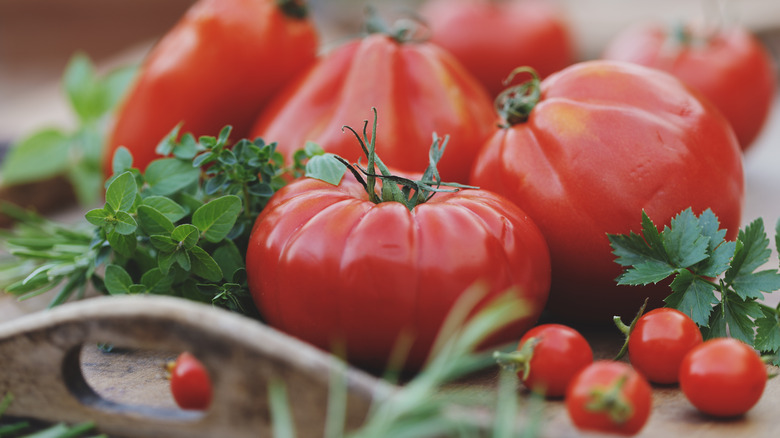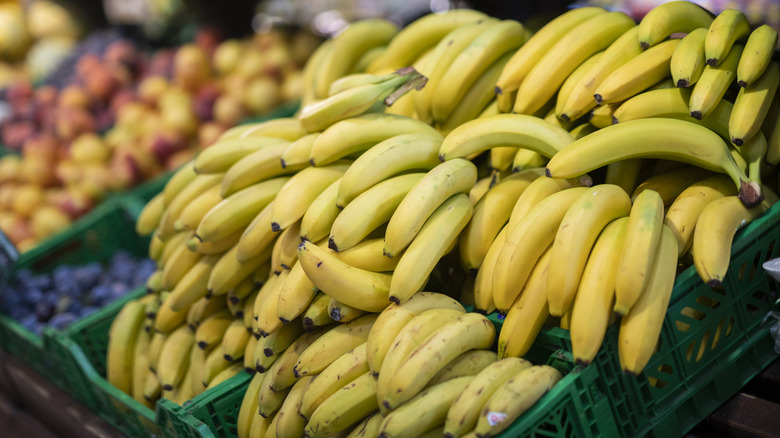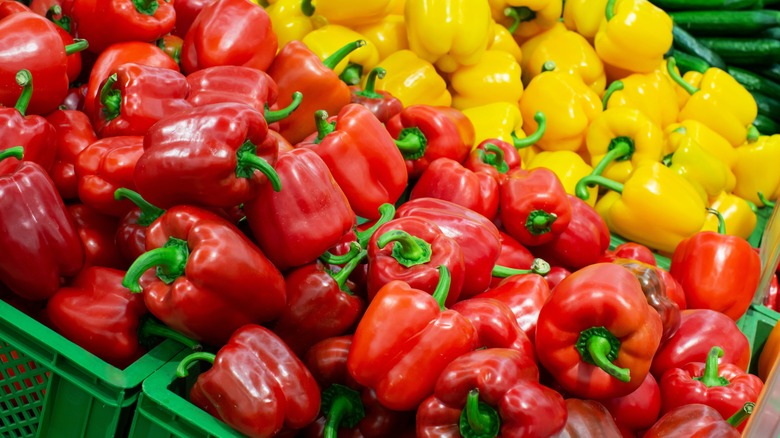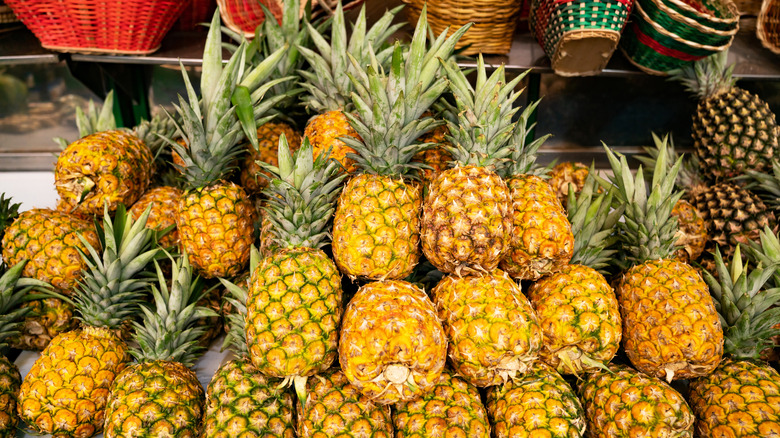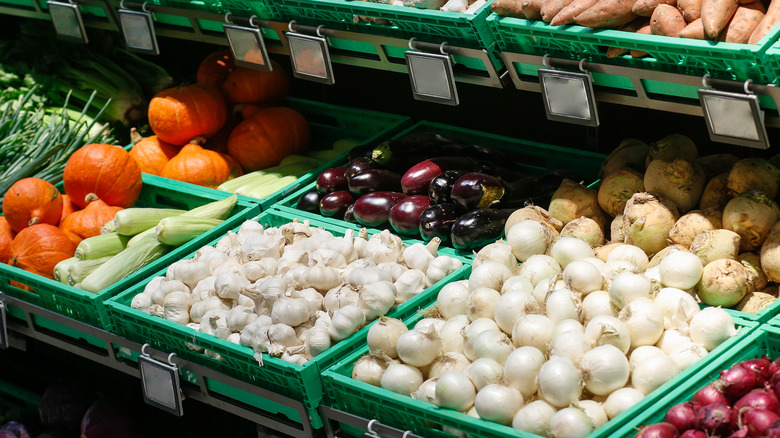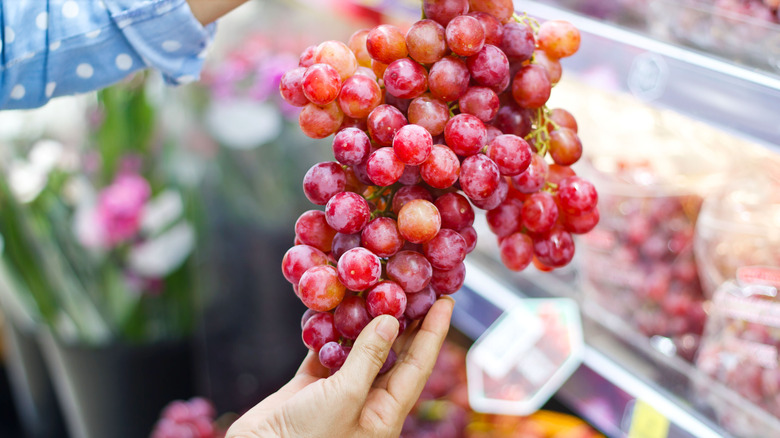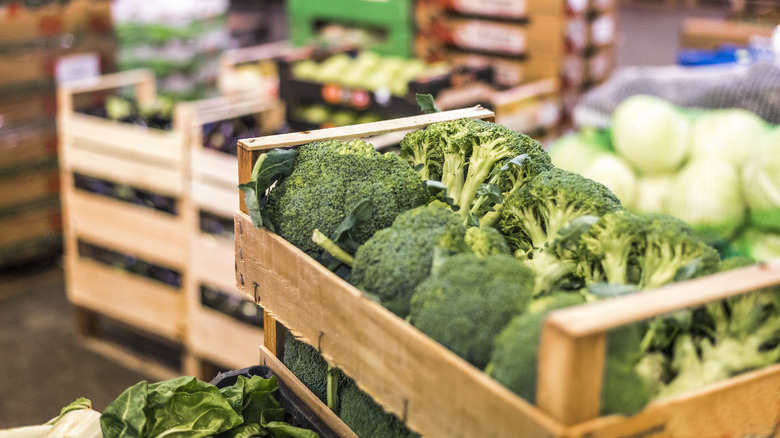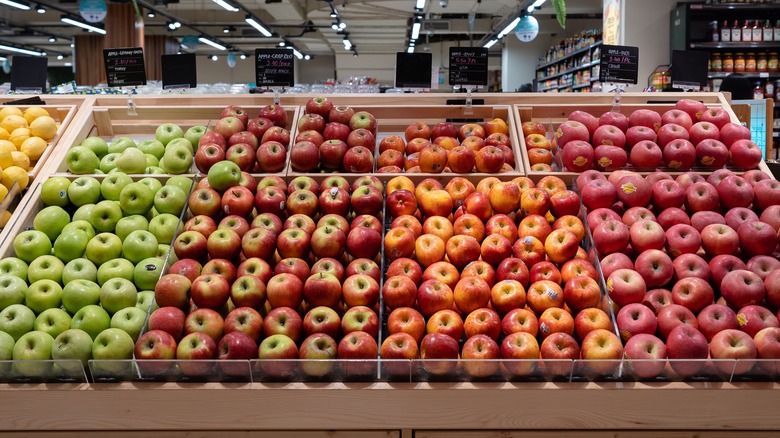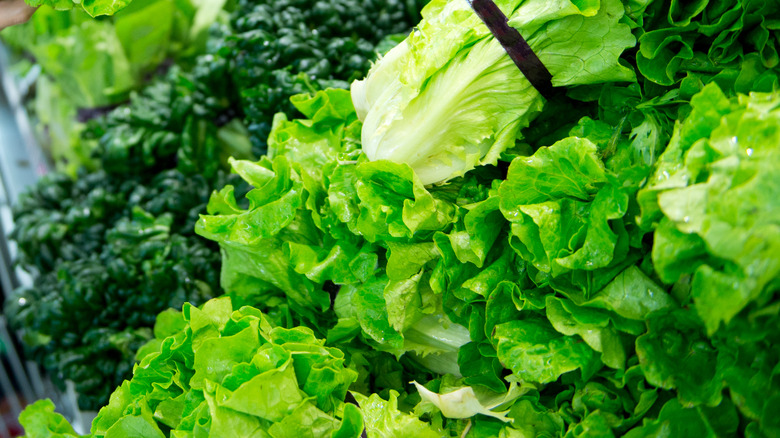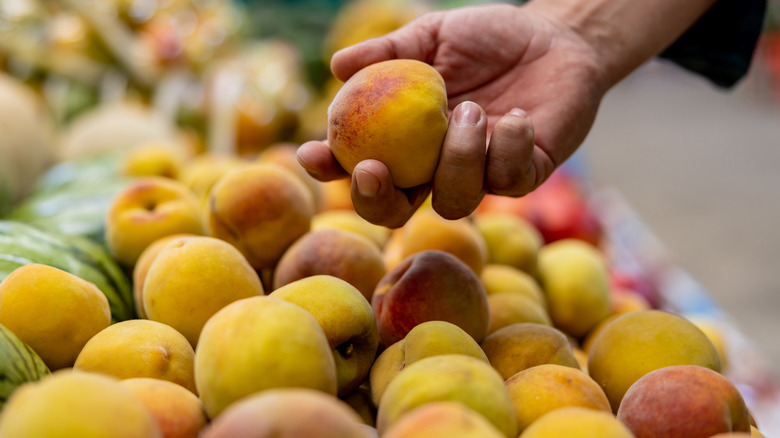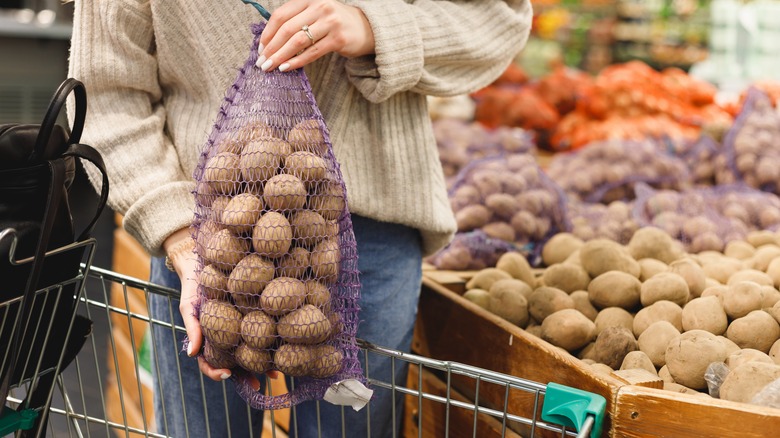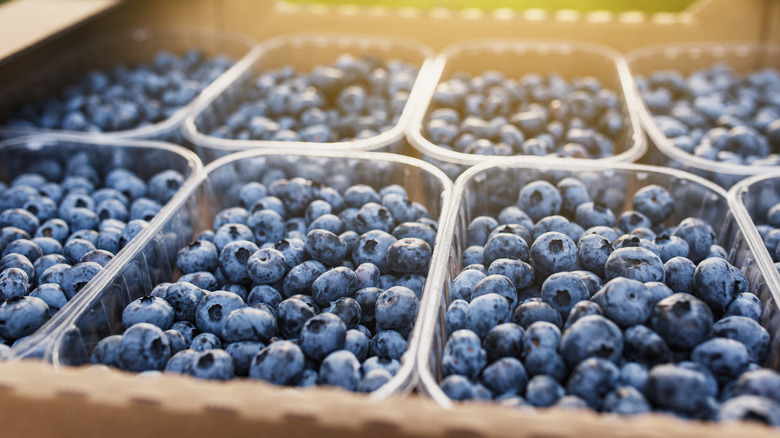Red And Green Flags To Look For When Buying Produce At The Store
Produce may very well be one of the most challenging types of foods to shop for, not only because the task itself is difficult, but because there's no way of avoiding it. If you want the juiciest, ripest tomatoes for marinara sauce or the most crisp and tasty apples for apple pie, you need to learn how to buy fruits and veggies carefully, instead of just choosing items at random because it's easier that way.
Bad produce that spoils early not only tastes disappointing, but wastes money, might be hazardous to your health, and can even attract pests or cause other fruits and veggies to spoil. While avoiding produce pitfalls can be tricky, each item has sensory cues you can look for to tell if it's a good pick. Below, we've listed some common pieces of produce and the red and green flags to always check for. Shop wisely, and you'll always buy the best produce, with a delicious flavor and fresh texture that lasts for several days after you purchase it.
Strawberries
Strawberries are basically nature's candy, meant to be sweet and aromatic with an alluring appearance. When shopping for a box of these berries, green flags include a bright red color and a rich scent that's both sweet and floral. The color tells you that the berries are ripe, and while they may darken in hue as days go by, they won't ripen after they've been picked — so if you buy pale, tart berries, don't expect them to get any sweeter as time goes on. Fresh green tops are also a good way to judge the perfect ripeness.
Conversely, the scent of strawberries can also be a red flag. Don't choose berries that smell acrid or like ammonia, as this indicates that they've spoiled. Brown or discolored leaves are another sign that your berries are past their prime, as are mushy spots or mold. Be sure to flip the container to check the strawberries on the bottom for any squished, pale, or even fuzzy specimens. To stave off mold growth in good berries, try rinsing them in vinegar. This is just one of several strawberry hacks you'll wish you knew sooner.
Tomatoes
There are many different types of tomatoes, and while factors like color, shape, and size can vary, there are some general signs you can look for to help you pick out the best ones. Green flags for tomatoes start with smooth, blemish-free skin, with no wrinkles, holes, or bruises. You'll also want to look for bright green stems and leaves. Tomatoes should also feel heavy. Each variety weighs differently, but tomatoes that feel heavy for their size are juicer. Finally, a scent that's sweet and slightly grassy is a definite good sign.
Most red flags for tomatoes are in opposition to the green flags. Avoid ones with blemishes, wrinkles, or mold. Mold spores on tomatoes can be black, green, or white, so keep an eye out for spots in these colors. A squishy texture also indicates that a tomato is overripe or even rotting. Additionally, if the fruits smell "off" or unpleasant, it's best to take a pass. Once you take your tomatoes home, you can store them at room temperature out of direct sunlight, though the fridge will help them last longer, especially if they're ripe and you're worried about spoilage.
Bananas
When it comes to produce that goes bad in a blink of an eye, bananas are one of the most infamous examples. This is because they continue to ripen after they're picked, so buying a bunch that isn't too far along is a must for longevity.
There are two big green flags to look for when choosing bananas: a bright yellow color and firm (but not hard) texture. Green bananas are underripe and brown ones are overripe, so only choose greenish bunches if you can wait a few days to eat them, or brown fruits if you're going to use them right away in banana bread. Otherwise, aim for an even, yellow color, though some green or brown spots are okay. When you gently press down on the peel, the fruit shouldn't feel too hard nor not too soft, but somewhere in the middle.
Red flags for bananas include loose or missing stems, or a lack of black tips at the bottom. Missing parts may cause the fruit to ripen too quickly, and can also expose the flesh to bugs, dirt, and other nasty things. An overly sweet or fermented smell is also a sure sign of an overripe bunch. To prevent spoilage, put your bananas in the fridge as soon as they're at the peak of ripeness.
Bell peppers
Bell peppers are rather a unique piece of produce. Since they come in a range of colors (and green ones are actually underripe versions of red, orange, and yellow kinds), their hue isn't a great way to tell if they're good. All it really indicates is flavor, with red being the sweetest, green being more bitter, and yellow or orange falling somewhere in between.
When choosing bell peppers, a major green flag is a shiny, unblemished skin, regardless of the color of pepper you're purchasing. Like tomatoes, the pepper should feel heavy in your hand, and the texture should be firm, not squishy.
The easiest way to tell if bell peppers have gone bad is to look for wrinkly skin and soft spots. Other red flags include black or brown spots; a sliminess on the exterior that doesn't rinse away with water; and mold spores, which may be white, brown, or green. An acrid smell is also an indicator that a pepper isn't worth buying. To keep any kind of bell pepper from going bad, store them in the crisper drawer of your fridge and make sure they stay dry, as they're sensitive to moisture.
Pineapples
Pineapples are another tricky item. They can range in color from greenish-yellow to golden, so their hue isn't always the best way to determine ripeness, and you can't observe the flesh underneath the spiky skin. Instead, the first green flag to look for should be vibrant green leaves, which indicate that the fruit is fresh. Your pineapple should also be heavy and firm, with a little bit of give when you squeeze it.
Additionally, you want a pineapple that smells sweet — this is one fruit that gives off a potent, pleasant scent when ripe. A pineapple with no scent may not be ripe, while one with a sour, fermented, or bitter odor is starting to go bad. Another way to tell if a pineapple has gone bad is to pay attention to the color and texture. While perfectly ripe fruits come in a few different shades, pineapples that are dark gold or brown are likely overripe, as well as those that feel squishy, spongey, or mushy.
Other red flags to look for include wilted leaves and fuzzy mold on the bottom. If you don't plan to eat your pineapple within the next day or two after purchasing, you should store it in the fridge.
Onions
Just like with tomatoes, there are several types of onions that are shaped, sized, and colored differently, but there are some general green flags you can look for, despite all of these distinctions. Choose onions that feel heavy, are firm in texture, and are mostly free of bruises or blemishes. Unlike many other types of produce on this list, a good, whole onion won't have much of a scent when you sniff it. It should smell like nothing at all, or just a little like a freshly-cut onion.
Red flags that can tell you if an onion has gone bad include mold and dark or mushy spots. And as you might guess, a spoiled onion will smell pretty horrible. An onion that has started to sprout is still safe to use, but those sprouts are an indicator that it's starting to go off, and you should use it as quickly as possible. White, yellow, and red onions all generally fare fine when stored in a cool, dry, place, but as with most produce, the fridge will help them last longer.
Grapes
We said earlier that strawberries are nature's candy, but grapes could also contend for that title. There are dozens of varieties of grapes, and whether you're shopping for green, red, or black ones, they're all supposed to look bright and appealing.
Green grapes should have an even yellow-green or chartreuse color, while red grapes should be primarily reddish-purple. Black grapes should be a rich, deep purple shade. If you see a white, powdery coating on your grapes, that's actually a green flag, too. This pale sheen is called the bloom, and it protects fresh grapes from moisture loss. Other green flags include grapes that are strongly attached to pliable stems, as well as a firm and plump texture. Not inspecting the stems to see if they're dried out is definitely a common mistake when buying grapes.
As you might guess, brittle stems with grapes that are loosely attached are both red flags. Additionally, avoid shriveled, squishy, or moldy grapes, and bags with a lot of loose fruits at the bottom, which can indicate rotting stems. To keep your grapes fresh, definitely store them in the refrigerator.
Broccoli
Broccoli is a sturdy veggie that has a reputation for lasting a long while, but it absolutely can spoil, so don't just pick any old crown you see in the produce section. One (literally) green flag to watch out for is a vivid, verdant color. Choose broccoli heads with a bright or rich green hue. The heads should be compact, with closed flower buds on top, and the top should also feel firm if you press on it with your hand. The stalks should also be hard, and the base of the stem should be cleanly cut, with no signs of rot.
One of the biggest red flags with broccoli are yellow and brown spots on the top, an indication that the crown is starting to go bad. Another bad sign is stems or stalks that have turned limp or rubbery in texture. Avoid florets that look bruised, moldy, or have enlarged buds or flowers. To store broccoli at home, wrap it loosely in a damp paper towel and store it in the fridge. You want to give it some airflow, instead of keeping it in an airtight container.
Apples
"One bad apple spoils the bunch" is a common saying for a good reason. Apples, as well as other produce like bananas and pears, release a gas called ethylene as they ripen, and they continue to expel it even after they're picked. Prolonged ethylene exposure not only rots the apples, but the fruits and veggies stored next to them. Avoiding overripe apples, which release the most ethylene, is crucial for the lifespan of all your produce.
Because there are so many types of apples, color isn't a great indicator of quality. Instead, look for blemish-free skin, a firm texture with no mushiness, and either no odor or a pleasant apple aroma. An apple with its stem still attached is another green flag, as a missing stem means the fruit will rot faster.
While some small blemishes are okay, red flags for apples include large bruises, holes, wrinkly skin, and soft spots. If an apple smells bad or is oozing liquid, it should obviously be avoided. If you want to make your apples last as long as possible, store them in the crisper drawer of your refrigerator. Otherwise, apples stored at room temperature will last one to two weeks.
Lettuce
While we refer to leaves of lettuce as "greens," there are many types of lettuce with different textures, colors, and shapes. This can make it a little more difficult to pick the best heads from the grocery store, but we've got the most popular varieties covered.
For iceberg lettuce, a head should have crisp leaves that are tightly-packed, while the stem end should smell slightly sweet. Green flags for romaine lettuce are similar, as you'll want tight bunches full of fresh-looking leaves, with no wilting or brown spots. Butterhead lettuce, also called bibb or Boston lettuce, is usually sold in plastic containers, so flip the box over on all sides to make sure it's full of healthy leaves, not squished or soggy ones.
Red flags for lettuce include wilted, rubbery leaves, or ones that have discolored or turned brown. Additionally, avoid greens that have started to smell bitter or look slimy or moldy. It's also a good idea to stay away from overly large heads of lettuce, as these can have tough leaves. To keep your greens from wilting, store them in your fridge's crisper drawer, and don't cut them until you're ready to use them.
Peaches
Like apples, peaches are the subject of a classic saying that many of us know all too well: "bruise like a peach." These soft and juicy fruits are super prone to bruising and spoiling, so thoroughly inspecting them before you buy is a must. The first green flag to look for is a vibrant color. Ripe yellow peaches will have a golden-red hue with a brighter gold color toward the stem. White peaches will be paler in color, but ripe ones should have a deep rosy blush over most of the skin.
A sweet, fragrant scent is also a green flag for most peach varieties. When you squeeze it, a ripe fruit will be just slightly soft, as opposed to hard or firm, which means it's not quite ripe. Another red flag that indicates the peach isn't ripe yet is green spots on the skin. Signs of spoilage include bruises, dents, wrinkles, and flattened or mushy areas. If a peach is squishy or leaking juice, definitely keep it out of your cart.
Once you get home, store your peaches at room temperature stem-side down to avoid bruising. If they start to get ripe too fast (and these delicate fruits can absolutely sneak up on you), move them to the fridge.
Potatoes
Potatoes come in several varieties, but the rules for picking out the good from the bad are generally the same. Green flags include a firm texture and smooth skin without bruises or discoloration. The spuds should also have an subtle earthy smell to them, like fresh soil, but they should look clean instead of being caked in dirt. Small "eyes" on the potatoes are okay, but don't buy them if they've started to sprout. A critical fact to know about sprouted potatoes is that they can contain a dangerous toxin called solanine, so while one or two small sprouts can be sliced off, anything more is a cause to toss the potato.
Another red flag is actually the color green: If your spuds are turning greenish, they're also past their prime, and might have developed solanine in the flesh that can make you sick. Other red flags include dark spots, mold, a mushy or wrinkled texture, a bad smell, and leaking. Most potatoes will stay good for a couple of weeks at room temperature, or a couple of months in the fridge.
Blueberries
Blueberries should live up to their name — one of the major green flags to look for is a deep, dark blue color. A light purple, greenish-white, or pinkish color means they're sour and underripe, and since these berries don't ripen after being picked, they'll stay that way. Another way to choose the tastiest blueberries at the grocery store is to look for a bloom, that same powdery dusting of white that appears on grapes. Likewise, a nice bloom indicates fresh and juicy berries.
Additional green flags for blueberries include smooth skins and a firm, plump texture. To check if the berries are firm, shake the container. Firm berries should rattle around like marbles. Avoid a container with moldy, mushy, or leaking berries, and check the bottom of the box for juice, which may indicate that the fruits are leaking. To keep your berries fresh, store them in a ventilated container that allows some airflow, as trapped moisture or condensation can quickly rot any variety of berries.
